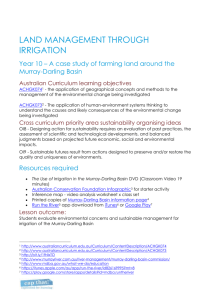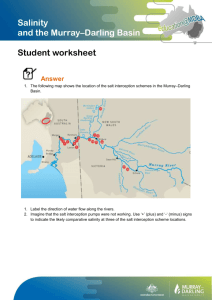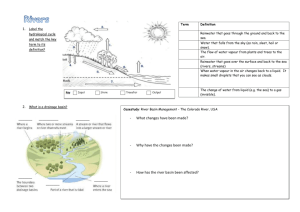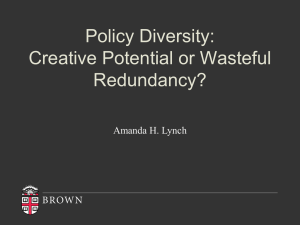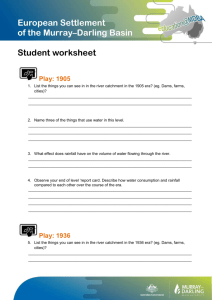56-OHS-A679
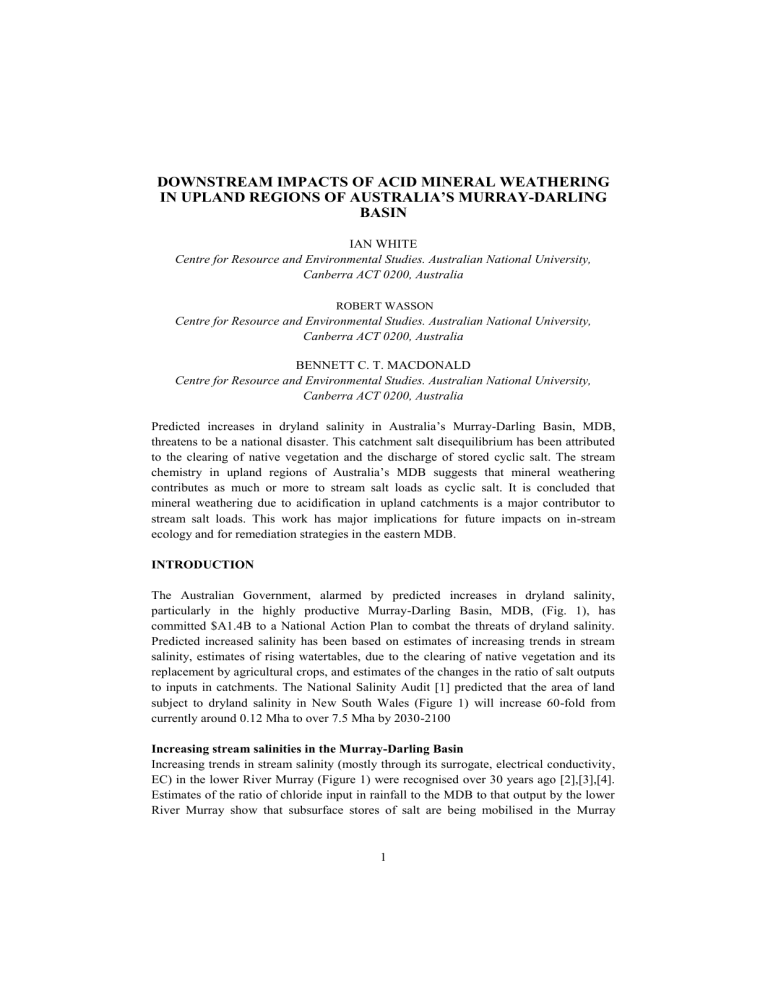
DOWNSTREAM IMPACTS OF ACID MINERAL WEATHERING
IN UPLAND REGIONS OF AUSTRALIA’S MURRAY-DARLING
BASIN
IAN WHITE
Centre for Resource and Environmental Studies. Australian National University,
Canberra ACT 0200, Australia
ROBERT WASSON
Centre for Resource and Environmental Studies. Australian National University,
Canberra ACT 0200, Australia
BENNETT C. T. MACDONALD
Centre for Resource and Environmental Studies. Australian National University,
Canberra ACT 0200, Australia
Predicted increases in dryland salinity in Australia’s Murray-Darling Basin, MDB, threatens to be a national disaster. This catchment salt disequilibrium has been attributed to the clearing of native vegetation and the discharge of stored cyclic salt. The stream chemistry in upland regions of Australia’s MDB suggests that mineral weathering contributes as much or more to stream salt loads as cyclic salt. It is concluded that mineral weathering due to acidification in upland catchments is a major contributor to stream salt loads. This work has major implications for future impacts on in-stream ecology and for remediation strategies in the eastern MDB.
INTRODUCTION
The Australian Government, alarmed by predicted increases in dryland salinity, particularly in the highly productive Murray-Darling Basin, MDB, (Fig. 1), has committed $A1.4B to a National Action Plan to combat the threats of dryland salinity.
Predicted increased salinity has been based on estimates of increasing trends in stream salinity, estimates of rising watertables, due to the clearing of native vegetation and its replacement by agricultural crops, and estimates of the changes in the ratio of salt outputs to inputs in catchments. The National Salinity Audit [1] predicted that the area of land subject to dryland salinity in New South Wales (Figure 1) will increase 60-fold from currently around 0.12 Mha to over 7.5 Mha by 2030-2100
Increasing stream salinities in the Murray-Darling Basin
Increasing trends in stream salinity (mostly through its surrogate, electrical conductivity,
EC) in the lower River Murray (Figure 1) were recognised over 30 years ago [2],[3],[4].
Estimates of the ratio of chloride input in rainfall to the MDB to that output by the lower
River Murray show that subsurface stores of salt are being mobilised in the Murray
1
2 catchment [5],[6]. In the lower Murray this is due to the discharge of both saline groundwater from Murray Basin aquifers (Fig. 1) and of drainage from irrigation areas
[7],[8],[9]. These findings have generated widespread concern over stream salinisation and the sustainability of current landuses [1].
Figure 1 . The Murray-Darling Basin, MDB, in southeastern Australia
Jolly et al. [10] compared estimates of the influx of airborne oceanic salt aerosols
(cyclic salts) deposited in rainfall to the calculated saltload exported by streams, using mostly sporadic measurements of stream EC to infer saltloads. They assumed that the only source of salt in the MDB is marine-aerosol-origin cyclic salts, deposited by rainfall, concentrated by evapotranpiration and stored in groundwaters [11]. The cause of dryland salinity in their model is native vegetation clearance and its replacement with annual agricultural crops that increase recharge. In this work we question this assumption.
Sources of salinity in the Murray-Darling Basin
Gunn [12], [13] argued that the main source of salts in groundwater in the NSW southern tablelands was from previously deeply weathered rocks, not cyclic salt. Acworth and
Jankowski [14] found there was no evidence for evaporative or transpirative concentration of salts in groundwater in the southeastern section of the Basin. Instead they believe that salt was imported into the MDB with silt during extensive dust storms during the last arid and windy interglacial period. Recently, mineral weathering has been claimed to influence stream salt-loads [15]. Together these form alternate hypotheses for the origin of salts in higher rainfall upland catchments: a store of salt from the intense and deep Tertiary weathering of rocks; a continuous, current supply from mineral weathering resulting from weak soil acids and aeolian deposits of salt-laden silts.
3
The conflicting hypotheses for sources of salts in upland areas in the MDB and the far-reaching policy implications of estimated stream saltloads and saltload output/input ratios for individual catchments have been reassessed recently [15]. The use of stream EC to infer stream salt loads [10] ignores information in the stream chemistry. We summarise here evidence from stream chemistry concerning the sources of salts in the eastern MDB.
RIVER CHEMISTRY IN THE MURRAY-DARLING BASIN
Catchment salt budgets for the MDB are based on the assumption that all ions contributing to stream EC are sourced from marine-origin cyclic salts [10]. Chemical and isotopic evidence suggests this is predominantly so in the lower Murray, where evapotranspiration-concentrated cyclic salts are discharged from brackish and saline
Murray Basin aquifers (Fig. 1) and from irrigation drainage [7],[9]. However, this assumption is less secure in upland catchments where mineral weathering may be an important source of dissolved salts [2],[12],[13], [16].
Mineral weathering
Acid-induced weathering of carbonates in the regolith is believed to be the major mineral weathering process for groundwater evolution in the Murray Basin [9]. The major source of weak acid is believed to be dissolved CO
2
, principally from soil respiration [7]:
CO
2
+ H
2
O + CaCO
3
Ca 2+ + 2HCO
3
-
2CO
2
+ 2H
2
O + CaMg(CO
3
)
2
Ca 2+ + Mg 2+ + 4HCO
3
-
(1)
Other mineral dissolution reactions occur under weakly acid conditions such as the hydrolysis of albite:
CO
2
H
2
O
2NaAlSi
3
O
8
H
9H
2
O
HCO
2H
-
3
Al
2
Si
2
O
5
4
2Na
4H
4
SiO
4
(2)
albite kaolinite
Such dissolution reactions, as well as exchange reactions with clays, increase the relative abundance of dissolved base cations, K, Na, Mg and Ca, above those found in rain-sourced cycle salts. The enhanced export of base cations from acidifying catchments is well documented [17]. Soil acidification is a major concern in southeastern and central catchments in the MDB [18]. Approximately 25% of the Basin contains problem acid and moderately acid soils or soils that have the potential to be acid.
The ratio bicarbonate to chloride ratio, [HCO
3
]/[Cl] (in equivalents) provides a measure of the fraction of solutes added by mineral weathering relative to cyclic salts sourced from rainfall [9],[16]. Other ratios such as ([Ca]+[Mg])/[Cl], ([Na]+[K])/[Cl],
4 and [H
4
SiO
4
]/[Na] provide additional information on mineral weathering. Figure 2 shows transects of [HCO
3
]/[Cl] and ([Ca]+[Mg])/[Cl] from median ion concentrations along the
River Murray [9], [16] Also shown are the median ratios for these species in
“uncontaminated” rainfall across the Basin, both close to 0.53 (equiv/equiv) [5],[6].
Groundwaters in the lower Murray Basin have [HCO
3
]/[Cl] that range between 0.02 for saline groundwater to 0.6 for fresh groundwater [6].
6
River Mu rray
[HCO 3]/[Cl]
([Ca]+[Mg ])/[Cl]
4
2
Rain
0
0 500 1000 1500 2000 2500
Distan ce Up stream (km )
Figure 2. Ion ratios for median concentrations of weathering products in the Murray
River upstream of the Murray mouth [8], [16]. The median ratio for both sets of species in rain across the Murray-Darling Basin is also shown.
10
1
[HCO 3]/[Cl]
[Ca+Mg ]/[Cl]
0.1
100 1000 10000 100000
1/[Cl] (eq /L)
Figure 3. Ion ratios indicative of mineral weathering as a function of the reciprocal of the median chloride ion concentration for median water chemistries in the River Murray [16]
5
Mineral weathering is the predominant source of dissolved species in the Murray for locations more than 1400 km upstream of the river mouth (Figure 2), above the confluence with Barr Creek and the Loddon River [8],[16]. In the upper reaches, weathering adds up to 6 times the solutes than does cyclic salt (in equivalents). When the ion ratios for median water chemistries in the Murray are plotted against the reciprocal of
[Cl] (Figure 3) a simple mixing model appears to describe the [HCO
3
]/[Cl] chemistry.
Other streams in the Murray-Darling Basin also have [[HCO
3
]/[Cl] and
([Ca]+[Mg])/[Cl] > 1 [15]. Ratios greater than 1 occur in upstream catchments that drain the southeastern slopes of the Great Dividing Range and in the Darling. Large areas of these eastern and southern catchments have been identified as having acid soil problems or potential problems [19]. Mineral weathering clearly contributes significantly to stream saltloads in a substantial number of the rivers that drain the western slopes of the Great
Dividing Range, together with the Darling. These tributaries with [HCO
3
]/[Cl] > 1 contribute over 80% of the runoff to the River Murray. [7].
Mineral weathering products and stream saltloads
To demonstrate the contribution of mineral weathering products to stream saltloads in the
Murray-Darling Basin, we have calculated the cumulative saltload due to Ca, Mg and
HCO
3
for the Murrumbidgee River, a major tributary of the Murray, downstream of Hay
Weir. It is compared in Figure 4 with the total saltload estimated for this site [10]. The cumulative saltload due to Ca, Mg and HCO
3 at this site on the Murrumbidgee over the decade 1985-1994 is 73% of the total saltload [10]. Not all this material is sourced directly from weathering products. However it is clear that mineral weathering is a major contributor to stream saltload at this site.
2,500,000
2,000,000
1,500,000
1,000,000
Ca+Mg +HCO 3
500,000
Jolly et al. (1997a)
0
1985 1990 1995 2000
Y ear
Figure 4. Cumulative saltload due to the weathering products Ca, Mg and HCO
3
in the
Murrumbidgee
6
An interpretation of this hydrologically complex site on the Murrumbidgee is that waters there are the result of mixing between two end members. One is a groundwaterlike component with higher chloride concentrations and relative composition (ion ratios) similar to those of Murray Basin groundwaters [9]. The other, a low chloride component, predominantly composed of mineral weathering products, which may be due to waters released from upstream impoundments as well as from surface runoff. The latter component contributes significant mineral weathering products to the river’s total saltload. The assumption that all salt exported this site is cyclic salt [10] is inconsistent with the river chemistry and leads to a considerable overestimate of the sourced cyclic saltload and the saltload output/input ratio.
Saltload output/input ratios
In order to estimate cyclic salt output to input ratios in catchments that export substantial mineral weathering products it is necessary to use a conservative tracer of cyclic salt, such as chloride [5] Table 1 compares estimates of mean saltload output/input ratios calculated using Cl as a tracer for selected sites with those estimated from TDS [10]).
When Cl is used as a tracer for cyclic salts the saltload output/input ratios for upland catchments are in most cases halved (Table 1). Catchments can be seen to either be in equilibrium, or in some cases storing cyclic salt. The one exception is the Lachlan at
Forbes, which remains an exporter of stored cycle salt. The assumption that all TDS in streams is due to marine-origin cyclic salts is not justified for many of the upland catchments of the Murray-Darling Basin we have examined. Mineral weathering contributes as much saltload to upland streams as does the input of cyclic salt (Table 1).
Table 1. Estimated average annual salt output/input ratios, SO/SI, for selected catchments based on chloride inputs in rain and stream outputs of chloride compared with those estimated by Jolly et al.
[20] based on TDS inputs and outputs
River
Murray
Murray
Location
Heywoods
Yarrawonga
56
61
Output Input
Mean EC [Cl]/TDS [Cl]/TDS SO/SI SO/SI
(kg/kg) (kg/kg) Chloride Jolly et al.
(1997)
0.11
0.14
0.23
0.23
0.88
0.77
1.88
1.26
Mitta Mitta Tallandoon
Kiewa Bandiana
Ovens Peechelba East
Murrumbidgee Angle Crossing
56
50
77
138
0.07
0.11
0.18
0.14
0.23
0.23
0.23
0.27
0.37
1.16
1.54
0.79
1.28
2.38
1.91
1.40
Murrumbidgee Halls Crossing
Goodradigbee Wee Jasper
Lachlan
Macquarie
Forbes
Dubbo
Castlereagh Coonamble
205
66
440
330
485
0.14
0.11
0.17
0.14
0.23
0.27
0.23
0.23
0.30
0.32
0.84
0.95
3.39
1.44
0.50
1.91
1.93
4.56
2.90
0.61
7
CONCLUDING REMARKS
It has been widely assumed that the principal source of salinity in streams throughout the
Murray-Darling Basin is the discharge of cyclic salts concentrated in groundwaters. The analysis carried out here of the estimation of stream saltloads and catchment salt balances in the Murray-Darling Basin suggests that mineral weathering due to weak acids is an important source of salinity in upland catchments of the Murray-Darling Basin. The implications of this overlooked source of dissolved salts are far-reaching in terms of natural resource management policy and practice in the Basin. Increasing soil acidity due to dryland farming practices is a major concern particularly in upland catchments. Present recommendations for remediation of dryland salinity in the MDB is to replant farmlands with deep-rooted native trees. This will do nothing to address increasing soil acidification and mineralisation.
ACKNOWLEDGMENTS
This work was supported by Land and Water Australia.
REFERENCES
[1] Murray-Darling Basin Ministerial Council, “The salinity audit of the Murray-Darling
Basin”, Murray-Darling Basin Ministerial Council, Canberra, (1999).
[2] Collett, K.D., “The present salinity position in the River Murray Basin”, Proceedings of the Royal Society of Victoria , Vol. 190, (1978), pp 111-23.
[3] Cunningham, R.B., and Morton, R., “A statistical method for the estimation of trend in salinity in the River Murray”, Australian Journal of Soil Research , Vol.
21,
(1982), pp 123-32.
[4] Morton, R., and Cunningham, R.B., “Longitudinal profile of salinity in the River
Murray”, Australian Journal of Soil Research , Vol. 23, (1985), pp 1-13.
[5]
Blackburn, G., and McLeod, S., “Salinity in atmospheric precipitation” in the
Murray-Darling Drainage Division, Australia. Australian Journal of Soil Research
Vol. 21, (1983), pp 411-34.
[6] Simpson, H.J. and Herczeg, A. L., “Delivery of marine chloride in precipitation and removal by rivers in the Murray-Darling Basin, Australia”, Journal of Hydrology,
Vol. 154, (1994). pp 323-350.
[7]
Simpson, H.J., and Herczeg, A.L., “Salinity and evaporation in the River Murray
Basin”, Journal of Hydrology , Vol. 124, (1991), pp 1-27.
[8] Herczeg, A.L., Simpson, H.J., and Mazor, E., “Transport of soluble salts in a large semiarid basin: River Murray, Australia”, Journal of Hydrology , Vol. 144, (1993), pp 59-84.
8
[9] Herczeg, A. L., Dogramaci, S.S., and Leaney, F.W.J., “Origin of dissolved salts in a large, semi-arid groundwater system: Murray Basin, Australia”, Marine and
Freshwater Research , Vol. 52, (2001), pp 41-52.
[10] Jolly, I.D., Williamson, D.R., Gilfedder, M., Walker, G.R., Morton, R., Robinson,
G., Jones, H., Zhang, L., Dowling, T., Dyce, P., Nathan, R., Nandakumar, Clarke, R., and McNeill, V., “Historical stream salinity trends and catchment salt balances in the
Murray-Darling Basin, Australia”, Marine and Freshwater Research , Vol. 52, .(
2001), pp 53-63.
[11] Alison, G.B. and Hughes, M.W., “The use of natural tracers as indicators of soilwater movement in a temperate semi-arid region”, Journal of Hydrology , Vol. 60,
(1983), pp 157-73.
[12] Gunn, R.H., “Shallow groundwaters in weathered volcanic, granitic and sedimentary rocks in relation to drlyland salinity in southern New South Wales”, Australian
Journal of Soil Research , Vol 23, (1985), pp 355-71.
[13] Gunn, R.H., and Richardson, R.H. “The nature and possible origins of soluble salts in the deeply weathered landscapes of eastern Australia”, Australian Journal of Soil
Research , Vol. 17, (1979), pp 197-215.
[14] Ackworth, R.I. and Jankowski, J., “Salt source for dryland salinity-evidence from an upland catchment on the Southern Tablelands of New South Wales”. Australian
Journal of Soil Research, Vol. 39, (2001), pp 39-59.
[15] White, I., and Wasson, R.J., Stream saltloads, catchment salt balances and sources of salts in upland catchments of the Murray-Darling Basin, Australia. Marine and
Freshwater Research (2004). Submitted.
[16]
Mackay, N., Hillman, T., and Rolls, J., “Water quality of the River Murray. Review of Monitoring 1978 to 1986”, Murray-Darling Basin Commission Water Quality
Report No. 1, Murray-Darling Basin Commission, Canberra, (1988), 62pp.
[17] Likens, G.E., “Biogeochemistry, the watershed approach: some uses and limitations”, Marine and Freshwater Research, Vol. 52, (2001), pp 5-12.
[18] Helyar, K.R., and Porter, W.M., “Soil acidity, its measurement and the processes involved. In
‘Soil Acidity and Plant Growth”, (Ed. A.D. Robson ), Academic Press,
Sydney, (1989).
[19] Murray-Darling Basin Ministerial Council, “Murray-Darling Basin Environmental
Resources Study”, Murray-Darling Basin Ministerial Council, Canberra, (1987).
[20]
Jolly, I.D., Dowling, T., Zhang, L., Williamson, D.R. and Walker, G.R., “Water and slat balances of the catchments of the Murray-Darling Basin”, Technical Report
37/97, CSIRO Land and Water: Adelaide, (1997).

